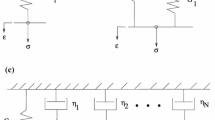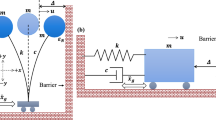Abstract
We consider the elastodynamic impact problem involving a one-dimensional finite-thickness piezoelectric flyer traveling at initial velocity \(V_0\) that collides with (and adheres to) a stationary piezoelectric target of finite thickness backed by a semi-infinite non-piezoelectric elastic half-space. We derive expressions for the stress, velocity, and electric displacement in the target at all times after impact. A combined d’Alembert and Laplace transform method is used to derive new numerically based solutions for this class of transient wave propagation problems. A modified Dubner–Abate–Crump (DAC) algorithm is used to invert the analytical Laplace transform domain solutions to the time domain. Unlike many authors who neglect electromechanical coupling in the initially unstressed region ahead of the shock, we consider this effect, which gives rise to the development of a tensile stress wave within the piezoelectric target ahead of the shock. To solve the problem, we derive a new piezoelectric impact boundary condition and apply it to the problem of a finite quartz (Si\(\text {O}_2\)) flyer impacting a lead zirconate titanate (PZT-4) target and find that the solutions obtained using the modified DAC algorithm compare well with those obtained using both a finite-difference time-domain method, and the commercial finite element code, COMSOL multiphysics.





Similar content being viewed by others
Notes
Electrodynamic jump conditions for moving boundaries are derived in [27], cf. p. 1187, Table 1.
The contact time is infinite since it is assumed that the flyer and target adhere on impact; this assumption is in fact unnecessary in those cases where flyer–target separation does not occur.
Similar behavior is observed in thickness-mode piezoelectric transducers excited by pulse voltage sources for ultrasonic applications [29].
References
Chen, P.J., Davison, L., McCarthy, M.F.: Electrical responses of nonlinear piezoelectric materials to plane waves of uniaxial strain. J. Appl. Phys. 47(11), 4759–4764 (1976)
Graham, R.A.: Second and third order piezoelectric stress constants of lithium niobate as determined by the impact loading technique. J. Appl. Phys. 48(6), 2153–2163 (1977)
Wang, X., Dai, H.L.: Dynamic focusing-effect of piezoelectric fibers subjected to radial impact. Compos. Struct. 78(4), 567–574 (2007)
Davison, L.: Fundamentals of Shock Wave Propagation in Solids. Springer, Heidelberg (2008)
Redwood, M.: Transient performance of a piezoelectric transducer. J. Acoust. Soc. Am. 33(4), 527–536 (1961)
Steutzer, O.M.: Multiple reflections in a free piezoelectric plate. J. Acoust. Soc. Am. 42(2), 502–508 (1967)
Clayton, J.D.: Modeling nonlinear electromechanical behavior of shocked silicon carbide. J. Appl. Phys. 107 (2010)
Graham, R.A.: Strain dependence of longitudinal piezoelectric, elastic, and dielectric constants of x-cut quartz. J. Appl. Phys. 6(12), 4779–4792 (1972)
Lysne, P.C.: One dimensional theory of polarization by shock waves: Application to quartz gauges. J. Appl. Phys. 43(2), 425–431 (1972)
Gazonas, G.A., Scheidler, M.J., Velo, A.P.: Exact analytical solutions for elastodynamic impact (2015) (in review)
Gazonas, G.A., Wildman, R.A., Hopkins, D.A.: Elastodynamic impact into piezoelectric media. U.S. Army Research Laboratory, ARL-TR-7056, September (2014)
Le, K.C.: On the impact of piezoceramic rods. Mech. Solids 3, 312–316 (1987)
Le, K.C.: Vibrations of Shells and Rods. Springer, Berlin (1999)
Dubner, H., Abate, J.: Numerical inversion of Laplace transforms by relating them to the finite Fourier cosine transform. J. ACM 15(1), 115–123 (1968)
Durbin, F.: Numerical inversion of Laplace transforms: an efficient improvement to Dubner and Abate’s method. Comput. J. 17(4), 371–376 (1974)
Crump, K.: Numerical inversion of Laplace transforms using a Fourier series approximation. J. ACM 23(1), 89–96 (1976)
Laverty, R., Gazonas, G.A.: An improvement to the Fourier series method for inversion of Laplace transforms applied to elastic and viscoelastic waves. Int. J. Comput. Methods 3(1), 57–69 (2006)
Su, Y., Ma, C.: Transient wave analysis of a cantilever Timoshenko beam subjected to impact loading by Laplace transform and normal mode methods. Int. J. Solids Struct. 49, 1158–1176 (2012)
Ing, Y., Liao, H., Huang, K.: The extended Durbin method and its application for piezoelectric wave propagation problems. Int. J. Solids Struct. 50, 4000–4009 (2013)
Sirwah, M.A.: Sloshing waves in a heated viscoelastic fluid layer in an excited rectangular tank. Phys. Lett. A 378, 3289–3300 (2014)
Randow, C.L., Gazonas, G.A.: Transient stress wave propagation in one-dimensional micropolar bodies. Int. J. Solids Struct. 46(5), 1218–1228 (2009)
COMSOL Multiphysics Reference Manual, version 4.4. Burlington, MA: COMSOL, Inc. (2013)
Mathematica Edition: version 9.0. Champaign, IL: Wolfram Research (2013)
Cady, W.G.: Piezoelectricity, vol. 1. Dover Publications, New York (1964)
Standards on piezoelectric crystals. In: Proceedings of the I.R.E.; New York: The Institute of Radio Engineers, pp. 1378–1395 (1949)
Lorrain, P., Corson, D.R.: Electromagnetic Fields and Waves, vol. 2. W.H. Freeman & Co., New York (1970)
Costen, R.C., Adamson, D.: Three-dimensional derivation of the electrodynamic jump conditions and momentum-energy laws at a moving boundary. Proc. IEEE 53(9), 1181–1196 (1965)
Sternberg, W.J., Smith, T.L.: The Theory of Potential and Spherical Harmonics. University of Toronto Press, Toronto (1964)
Zhang, H.L., Li, M.X., Ying, C.F.: Complete solutions of the transient behavior of a transmitting thickness-mode piezoelectric transducer and their physical interpretations. J. Acoust. Soc. Am. 74(4), 1105–1114 (1983)
Davison, L., Graham, R.: Shock compression of solids. Phys. Rep. Rev. Sect. Phys. Lett. 55(4), 255–379 (1979)
Hopkins, D.A., Gazonas, G.A.: Wave propagation in second-order nonlinear piezoelectric media. U.S. Army Research Laboratory, ARL-TR-5766, September (2011)
Author information
Authors and Affiliations
Corresponding author
Appendices
Appendix 1: Laplace transform domain functions \(\overline{F}_1(s), \overline{G}_1(s),\; \text {and}\; \overline{D}_1(s)\)
Appendix 1 lists the Laplace transform domain functions \(\overline{F}_1(s), \overline{G}_1(s),\; \text {and}\; \overline{D}_1(s)\) that are substituted into (60) for the Laplace transform domain stress \(\overline{\sigma }_1(x,s)\) in the target that is inverted to the time-domain using the Mathematica algorithm in “Appendix 2.”
where
where
where
Appendix 2: Mathematica code for determining the numerical ILT using the modified DAC algorithm [11, 17]
The following Mathematica [23] source code is useful for determining the numerical inverse Laplace transform (ILT) of functions with jump discontinuities using the modified Dubner–Abate–Crump (DAC) algorithm [11, 17]. Figure 5 illustrates the stress time history in the target and use of the ILT algorithm for a set of synthetic flyer and target elastic and piezoelectric properties.
1.1 Mathematica code to compile the Laplace transform domain function \({\overline{\sigma }}_1(x,s)\)
\(\overline{\sigma }_1(x,s)\) in the above code is given by the following Laplace transform domain expression for the stress in the target
where
and
1.2 Mathematica code to perform the ILT of function Stress defined in “Mathematica code to compile the Laplace transform domain function \({\overline{\sigma }}_1(x,s)\)”
1.3 Mathematica code to plot the numerical ILT of \(\Sigma \) defined in (85)

Appendix 3: Verification of the numerical ILT solutions with the closed-form results of Le [12,13]
In this Appendix 3, we determine the relative error between the exact solution for the electric displacement derived by Le [12, 13] and the numerical ILT solution using the Mathematica algorithm listed in “Appendix 2.” Le [12, 13] studies the problem of a finite-length piezoceramic rod, traveling at an initial constant velocity, that impacts a second, identical, but stationary piezoceramic rod; exact solutions for electric displacement and stress are provided, up until the first wave reflection, for the case when the external ends of the rods are electrically short-circuited. For identical piezoceramic rods, the electric displacement can be written as
Le [12, 13] provides closed-form analytical expressions for the relative displacement \(u(l,t)-u(-l,t)\) of the rod ends used in Eq. (87) and illustrated in Fig. 6 for the time interval \(0 \le t \le 2l/c\). Since the piezoceramic rods are finite in extent, the electric displacement sinusoidally oscillates in time and does not diminish in amplitude as in the example where the target is backed by a semi-infinite half-space (Fig. 4); the PZT-4 constants used to generate the solutions appearing in Fig. 6 can be found in Table 1.
Comparison of numerical and exact displacement current time histories in a 5-mm-thick PZT-4 target under impact by a 5-mm-thick PZT-4 flyer with initial velocity \(V_0= 5\) m/s, using PZT-4 material parameters from Table 1; the exact solution of Le [13] is plotted for the time interval time \(0 \le t \le 2l/c\)
If D(t) represents the exact value of the electric displacement given by Eq. (87), and \(\widetilde{D}(t)\) is the approximate ILT value; then, the relative error, relerr, of \(\widetilde{D}(t)\) is given by
It can be shown that \(-\text {Log}_{10}[|\text {relerr}|]\) (see Fig. 7) is a measure of the approximate number of significant digits in the solution. Note that relerr is defined only if \(D(t) \ne 0\).
Numerical accuracy of the modified DAC displacement current solution depicted in Fig. 6 for two tolerance values tol \(= 10^{-5}\) and tol \(= 10^{-7}\) used in the ILT algorithm [Eq. (85)] over the time interval \(0 \le t \le 2l/c\); over this interval, the numerical solution accuracy ranges from about 3 to 9 significant digits
Rights and permissions
About this article
Cite this article
Gazonas, G.A., Wildman, R.A., Hopkins, D.A. et al. Longitudinal impact of piezoelectric media. Arch Appl Mech 86, 497–515 (2016). https://doi.org/10.1007/s00419-015-1042-3
Received:
Accepted:
Published:
Issue Date:
DOI: https://doi.org/10.1007/s00419-015-1042-3






